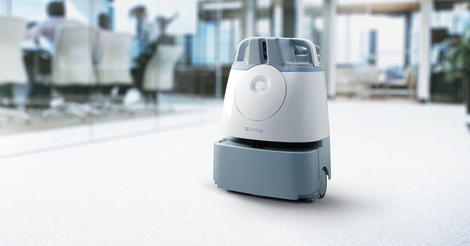
Whiz, the latest vacuum from SoftBank Robotics isn’t nearly as charming as Pepper or its tiny counterpart NAO, but it’s certainly more practical. Today in Las Vegas at the ISSA trade show for the Worldwide Cleaning Industry Association, SoftBank Robotics America (SBRA) and ICE Robotics introduced Whiz to the North American market. The most interesting part of the announcement is the business model. Whiz will be offered as a subscription, priced at $499 per month.
“When we start to look at the model in the ecosystem of what it costs to clean an entire building, this really starts to get interesting and we can create immense value,” says Brady Watkins, Head of Commercial Automation at SBRA.
We spoke with Watkins and SoftBank Robotics’ head of strategy Kass Dawson to learn about Whiz.
“It may seem like a little bit of a leap for us to go into Whiz and cleaning industry,” Dawson admits. “But I want to make it clear that based on the vision we’re driving toward; this is really our second step at really defining what automation can be in the marketplace.”
Following the success of Pepper, the humanoid service assistant, Whiz is yet another step toward automating repetitive tasks in the workforce.
The commercial-grade robotic vacuum launched in Japan and select markets earlier this year and has been operating in commercial spaces across the country this year in pilots at hotels, offices, campuses, and airports, such as the Cincinnati/Northern Kentucky International Airport (CVG).
When asked why they chose those particular commercial locations, Watkins and Dawson gave a straightforward answer: Because they have lots of carpet. Robotic vacuums are well-established in the consumer market, but the commercial cleaning sector remains mostly manual.
“There are currently no other commercial sweepers that have penetrated or have any scale within the cleaning industry to date,” Watkins says.
There will likely be plenty of competition in this space, but there’s room for more than one robot in the industrial cleaning industry, which is projected to grow by US$15.9 billion, according to Global Industry Analysts.
Watkins explains that vacuuming in commercial buildings is usually done as a spot clean, where cleaning staff is instructed to vacuum any visible dirt on the carpets. Cleaning crews typically operate at night with limited time to clean everything from bathrooms to surfaces and all floors.
“It’s usually midnight to am cleaning, you only have a certain set of hours to deliver 15 to 20 tasks,” he says. “So, imagine you’re a janitorial worker, and you have to go clean your building, you have to get everything done in six hours.”
Under those time constraints, vacuuming becomes a lower priority. However, carpets collect dust, dirt, dander, and bacteria –especially in public places like an airport or hotel lobby.
“The industry says carpet is your number one filter for allergens, dirt, and dust, Watkins says. So if there isn’t enough time to properly clean that filter, all that gunk lurks below our feet, between the carpet’s fibers. Enter the robots, which can clean the entire floor consistently and repeatedly.
During the pilots in commercial buildings such as the Cincinnati airport, Whiz extracted the dust that had been missed by the standard spot cleaning methods.
“In the first 30 minutes of vacuuming the carpet, our four-liter bag is full,” Watkins says. He adds, “The aha moment really comes when we take out that bag in 30 minutes, which would probably take more like two weeks to be able to fill up in your standard expectation. We rip that bag open and it’s full of dust and debris.”
Whiz can clean areas up to 15,000 square feet, the size of 3 basketball courts, for 3 hours on a single battery charge. The vacuum is smaller than you might expect for such large commercial spaces, standing at approximately three feet high by two feet, with a zero-turn radius.
It is powered by BrainOS, the technology behind large self-driving commercial cleaners such as the Factory Cat and Tomcat brands, which look like driverless Zambonis for cleaning factory floors.

Whiz uses BrainOS to navigate autononomously after a human teaches it the route.
Softbank Robotics
Human operators initially teach Whiz where to go by riding behind it, pushing it to define the route. Then once the route is defined, you line it up, press a button, and it uses BrainOS to navigate itself and avoid obstacles.
According to Dawson, the commercial cleaning sector is just one of several industries that SoftBank is looking to disrupt with automation.
“We’re looking for other industries that have highly repetitive tasks, as well as industries that we think are ripe for some innovative solutions where we know robotics is going to play a major role moving forward,” Dawson explains. He says this will likely include warehousing and logistics, as well as foodservice and hospitality. This could include the preparation and delivery of food, for example. You might check into a hotel and be greeted by a Pepper robot, then later have your room service delivered by another robot.
